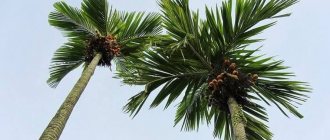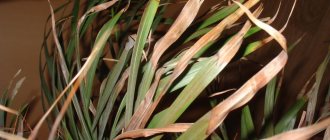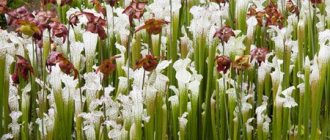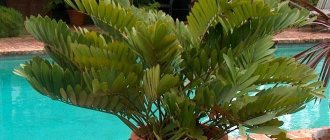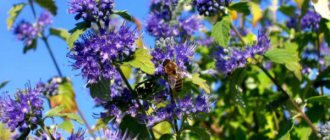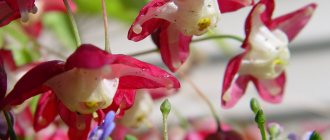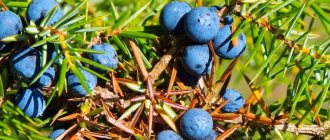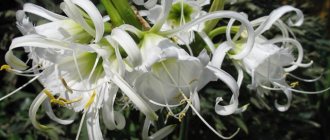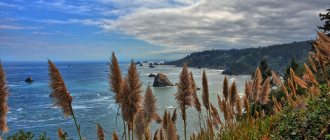Features of govea
Govea began to be cultivated back in the Victorian era, and it was grown in estates, decorating spacious halls, as well as in palaces. An interesting fact is that in nature such a plant is found only on Lord Howe Island, which belongs to Australia. This genus is considered part of the Palm family, but it unites only 2 species. Under natural conditions, the height of such a plant can reach up to 12–15 m. When grown indoors, the height of such a palm tree most often does not exceed three meters, but it also happens that in a spacious hall the plant grows up to five meters in height, but this is quite rare phenomenon.
This palm is single-stemmed; on its upper part a large number of stems are formed, on which there are large pinnately dissected leaf plates. Chovea cultivated indoors while young forms a large number of basal shoots. However, as she grows up, she develops a single powerful trunk. It is characterized by very slow growth; during the year it grows only 2 or 3 new leaf plates. If such plants are properly cared for and provided with suitable conditions for growth, then they can live for several decades.
Indoor palm tree / How to care for the Howea palm tree?
Top dressing
Palm trees are responsive to feeding and require feeding during the growing season and throughout the entire life cycle. The exception is the winter period, during which the plant's metabolism slows down and growth stops. As a top dressing, organic and mineral mixtures specially designed for palm trees are used. Apply to the soil at intervals of 2-4 times a month. At the same time, the composition of the applied fertilizers alternates.
Related article: Style or bad taste: top 5 mistakes in the interior
Mature palm trees that are more than 10 years old need to add potassium and magnesium to the fertilizer.
Important: after transplantation, the plant begins to be fed only after a month.
Caring for howea at home
Growing govea at home is quite simple. It is one of the most unpretentious palm trees. Minor mistakes in care will not cause her any significant harm. However, if you want the palm tree to grow very beautiful and lush, then you must take good care of it and provide optimal conditions for growth.
Illumination
When choosing a place for govea, you should take into account that it can grow well both in shade and in direct sunlight. However, young bushes should be protected from the scorching rays of the sun. A mature palm tree can grow well in bright light, but the plant should not be exposed to direct sunlight for long periods of time.
Govea grows best in a place that is well lit, but the light must be diffused. The palm tree grows well on a north-eastern, south-eastern or northern windowsill. If desired, the plant can be placed in the back of the room, but placing it in the shade is not recommended because due to poor lighting it will begin to wither. In the summer, the palm tree can be taken out into the fresh air, but you should choose a place for it that will be well protected from the scorching rays of the sun.
Temperature
In summer, palm trees grow best in warm conditions (23 to 27 degrees). A palm tree can grow well in a warmer room, but in this case it should be systematically moistened with a sprayer and the room should be ventilated frequently. During the winter months, the plant has a dormant period, and during this time it should be at a temperature of 15 to 18 degrees.
The crop is not afraid of short frosts, as well as slight frosts (down to minus 5 degrees), but only if the root system is well insulated. Otherwise, if the bush stays in the cold for 3 to 5 days, this will lead to its death. Sudden changes in temperature at night and during the day cannot cause much harm to the plant. However, this should not be abused; it is better if the plant experiences as little stress as possible.
Air humidity
Govea grown indoors does not have any special requirements for air humidity. Experts recommend moistening the crown of the palm tree on hot days in the summer. In the winter months, it is recommended to place it as far as possible from heating appliances. If the air humidity level is very low (less than 30%), then an open container filled with water should be placed near the hovea. If the plant is left in a room with very dry air for quite a long time, then it may begin to dry out. If excessively high humidity (more than 70%) is observed in the room for a long time, this can lead to the appearance of rot on the stem.
Watering
The palm tree needs regular, abundant watering. Make sure that the top layer of soil mixture in the container is always slightly damp. However, do not allow liquid to stagnate in the root system, as this can lead to rot on the root system and stem.
In summer, watering should be more frequent (4 to 6 times every 7 days). In winter, the bush is watered only after the top layer of the substrate in the pot has dried, but in no case allow the earthen clod to dry out. For irrigation, it is best to use water at room temperature, which should be well settled beforehand (it can be passed through a filter). Rain or melt water is perfect for this.
Fertilizer
Govea is fed only in the spring and summer; for this purpose, complex mineral fertilizer is used for indoor deciduous plants or for palm trees. Feeding should be done once or twice a month. If desired, you can feed the plant by the foliage, but do this through watering. Experienced gardeners recommend alternating these methods. For foliar feeding, use a low concentration fertilizer solution. Before using the product for the first time, be sure to carefully read the instructions on the package.
Hovea transplant
While the palm tree is young, it needs to be replanted every year. As the root system grows, the size of the container must be increased. After she turns 5 years old, she can begin to be replanted once every 2–4 years. However, it must be taken into account that the soil mixture is gradually depleted and over time it must be replaced with fresh nutritious soil. The palm tree needs to be replanted in the spring, but if absolutely necessary, this can be done in the fall.
For replanting, it is best to use a purchased soil mixture for indoor palm trees. If you wish, you can do it yourself; to do this, you need to combine leaf and turf soil, humus, river sand and peat in a ratio of 2:2:1:1:1. To enrich the substrate, it is recommended to add a small amount of wood ash and bark. Before planting, do not forget to first make a layer of drainage at the bottom of the pot; for this, use crushed stone, ceramic shards, brick chips or expanded clay.
replanting Howea and caring for a palm tree at home
Growing and care
Necessary conditions for cultivation
In general, there is nothing unusual for growing Howea Forster, and when purchasing a palm tree you need to take into account the standard requirements for the level of lighting, temperature conditions and type of land, since only if these minimum conditions are met can you successfully grow a truly gorgeous plant.
Of course, everything is purely individual, so let's see what our beautiful tropical plant prefers.
Lighting
Hevoy Forstera cannot withstand direct sunlight on its leaves, so if you place this plant on a windowsill without a curtain or tulle, your plant will quickly wither and dry out.
It will be ideal if you place the plant either in partial shade, or if it receives a maximum of 60% sunlight. The period from April to August when exposed to rays is especially dangerous, so at this time it would be best to move the tree deeper into the room.
In addition, if you want the symmetry of the howea to be preserved, which will have a very good effect on the decorative component of the plant, do not forget to rotate the plant 180 degrees every couple of weeks. If there is excess sunlight in your room, you can tell by yellow and brown spots on the leaves.
Under ideal lighting conditions, your hovea will have from nine to twelve leaves, but under poor conditions their number will hardly reach six.
Humidity and temperature
If we take into account the natural habitat of the palm tree, it becomes clear why the palm tree loves warmth, which means that the room must be at least +16 degrees Celsius.
But still, if you want to give the plant comfort, then the temperature should be above 20 degrees Celsius in the summer, and at least 15 degrees in the winter. Mature trees can cope well with temperature changes, even down to zero.
As for humidity, it is worth remembering the tropics, since Hevoa Forstera does not tolerate aridity, which means that the air humidity in the room must be at least 60%.
But do not overdo it: high humidity can only lead to damage to the plant (yellowing of the leaves or even blackening of the tips). For the comfort of the plant, you can spray it with a spray bottle in the summer.
Soil for planting
Any type of howea is not very demanding on the composition of the soil in which it grows. But it is still better to choose good loamy soils with drainage.
As a basis, you can take ready-made soil, which is sold in stores specifically for ornamental palm trees, and then add soil and humus from the leaves. For excellent drainage, you can use perlite.
Important: the soil should not be damp or too wet, otherwise acidification may occur and the plant will be destroyed.
Interesting: palm trees are great for improving communication skills and increasing the enthusiasm for life of everyone at home.
How to plant Hevoy Forster
This type of palm tree is often sold in the store already in pots, but if you decide to plant it yourself, you can do this:
- by seed;
- by dividing the bush.
Reproduction
Growing from seeds
As a rule, this method is used (only fresh seeds are used), but you need to immediately evaluate all the labor costs of the method. In the early stages of development, howea is characterized by slow growth, and you will need to wait five to seven years to see the results of your labor.
Sowing is carried out from late February to early March, and peat and sand are used as the substrate. When you are just in the germination period, the air temperature should be at least 25 degrees Celsius.
The first sprouts will appear in 2-10 months, and as soon as you notice the appearance of the first leaf, the seedlings will need to be transplanted into separate pots.
Important: when planting, try not to tear off the seeds, as they can supply your palm with nutrients for a long time.
Propagation by dividing the bush
Some of those who are interested in plant growing practice propagation of Howea Forster by dividing the bush, which is easiest to do when transplanting a palm tree.
The only thing you need is to separate the shoots from the side of the mother bush and transplant them into another container. For plants that have recently been transplanted, it is very important to maintain greenhouse conditions, which will speed up the process of root formation and facilitate establishment.
Before starting the transplantation procedure, prepare sterilized soil (turf soil + leaf humus + perlite (1:2:2)) and a large container in which the root system of the fragile palm will be comfortable.
When removing the bush from the old pot, loosen the soil, after which you need to remove the soil and divide the plant.
Reproduction methods
Growing from seeds
Govea can be propagated by seed and by dividing the bush. However, it is almost impossible to obtain seeds from howea, because it does not bloom under indoor conditions. However, if desired, seed material can be purchased in the store, but it must be taken into account that their germination rate will not exceed 50 percent. If you do manage to get seedlings, they will become beautiful palm trees only after 2 or 3 years.
Dividing the bush
During the replanting process, if necessary, cut off the young shoot from the trunk and plant it in a soil mixture consisting of sand and peat. However, be prepared for the cutting to not take root. If it does give roots, it will be possible to plant it in a permanent pot with nutritious soil mixture only after 2-3 months.
The simplest option is to purchase a new palm tree from a nursery.
Diseases and pests
Mites, thrips and scale insects, and in rare cases, mealybugs can settle on howea. If liquid stagnates in the soil mixture, gray or black rot may affect the plant. Both diseases and pests can be gotten rid of with the help of special preparations sold in specialized stores.
In order to prevent the appearance of pests, you need to systematically inspect the bush, special attention should be paid to the underside surface of the leaf plates. Also regularly carefully inspect the surface of the substrate; if a gray or white coating has formed on it, this may be due to the fact that mealybugs have settled in the soil mixture or a fungus has appeared.
Possible problems
- If brown or yellow spots appear on the foliage , this may be due to excessively low levels of air humidity or sunburn.
- Curling of the tips of the leaf plates may be due to very low air temperatures or exposure to a draft.
- Drooping, drooping leaves indicate that there is stagnation of fluid in the root system.
- A white coating on the foliage occurs when pests have settled on the bush.
- Withering and flying of the lower leaf blades is most often due to the fact that the palm tree does not have enough nutrients.
- Very slow growth and faded foliage are a sign of very poor lighting.
Possible difficulties when growing howea
The plant can get pink rot, leaf spot, root and stem rot. To cope with them, it is necessary to use fungicides. Processing is carried out according to the instructions in the instructions on the packaging.
Spider mites and mealybugs that can attack the plant must be combated with insecticides.
Difficulties may also arise such as:
- The appearance of brown spots on the tips of leaves. This happens if the wrong water is used for irrigation or the room is too hot.
- The appearance of brown elliptical spots on the leaf blades indicates that there is too much light;
- Drying of the tips on young leaves and yellowing on adults indicates a lack of water;
- Drooping, dark leaves that are beginning to rot indicate an excessive amount of liquid;
- From mid-autumn until the end of winter, the palm tree does not grow. In this case, there is no reason to worry; during this period the plant enters the stage of vegetative rest.
Types of Howea
Howea differs from other representatives of the Palm family not only in that in nature it can be found only on one island, but also in that it has very few varieties. In many regions with warm and mild climates, this palm tree is grown outdoors and successfully propagated artificially. However, in regions with colder climates it is cultivated exclusively indoors.
You can decorate your home with any of two types of govea:
Howea belmoreana
A palm tree growing in nature can have a height of 10 to 12 m (sometimes higher). Dark green, beautifully curved leaf blades can reach from 2 to 2.5 m in length. On the surface of the downward expanding trunk, each of the dead leaf blades leaves a ring mark. The lush crown has an emerald hue. When grown indoors, this palm tree differs from the wild one only in height, so it can grow up to 2–2.5 m.
Howea forsteriana
This species differs from the previous one in that it is taller. Under natural conditions, such a plant can reach a height of 13 to 15 m. In the upper part of the straight trunk, long petioles are formed, on which large leaf plates of a pinnately dissected shape grow, and they are painted in a bright green color. In adult palms, the length of the leaf blades can reach four meters. When grown indoors, the height of the bush can reach 3–3.5 m.
Hovea grown at home does not bloom. But only palm trees grown in open ground or in a greenhouse bloom.
Palm Howea (Kentia). Unpretentious Palm Trees FOR APARTMENT.
